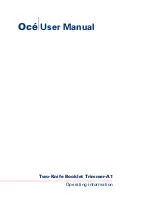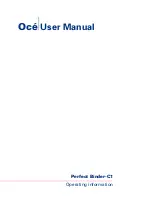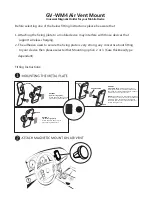
5
Helmet positioned too high may make the shell fall; helmet positioned
too low may be uncomfortable. The optimum position of the helmet on
operator's head may be set with the
B
band in the upper part of the
headgear.
Verify band adjustment by putting the helmet up and down when fitted
on the head. If the band is adjusted correctly, the helmet should be stable
on operator's head. If positioning is incorrect, readjust the band.
n
Helmet-to-face distance adjustment:
To adjust this distance, unscrew mounting nuts
C
and put the screws
through square holes
D
in headgear frame to move the helmet closer to
or further from the face. When the right distance is set, tighten the nuts
C
.
NOTE
!
Perform the adjustment for both sides of the helmet. The smallest
possible filter-to-eye distance is recommended for the best sharpness.
n
Helmet angle adjustment
If helmet angle is not right for the operator, it may be adjusted:
–
Loosen mounting screws
C
.
–
Change helmet angle.
–
Tighten mounting screws
C
.
CAUTION!
The correct helmet angle protects against spatter and radiation
reaching operator's chin.
8.
USE:
n
Helmet power source
The helmet is powered with two lithium CR2450 3 V batteries charged by
solar cells. It provides battery life of 5000 hours under normal operating
conditions.
Filter power is automatically controlled by optical sensors.
The internal control panel has the TEST button, which can be used to
control correct operation of helmet systems (the operation mode switch
should be set to welding), and an LEDy indicator for empty batter. The
low voltage diode is off when power provided to the filter is sufficient.
When the diode is on, the batteries should be replaced.
n
Helmet shade selection:
Find the right shade for your welding
process in the table on page 4 and set the
operation mode switch on the left side of
the helmet to the appropriate position
5–8
or
9–13
. Rotate the
SHADE
knob and
set to the right value of darkening cover.
For grinding, set the operating mode
switch to
SZLIFOWANIE/GRIND
, and
turn off the shade.
n
Setting sensitivity and clearing time after welding:
Upon welding, the filter automatically switches from clear to dark in
1/25,000 s.
Stepless regulation of filter sensitivity to
electric arc can be set with the
CZUŁOŚĆ/SENSITIVITY
knob on the right
side of the helmet. Higher settings are
recommended for low currents or TIG
welding; lower values are recommended
for high currents or MIG/MAG welding.
The operator may adjust clearing delay
time with the 3-position
OPÓŹNIENIE/
DELAY
switch located on helmet body near the
CZUŁOŚĆ/SENSITIVITY
knob. This switch offers three settings of filter reaction time:
FAST
– 0.1-
0.2 s /
MIDDLE
– 0.2-0.5 s /
SLOW
– 0.5-0.8 s.
The delay compensates for afterglow on the workpiece. MIN (minimum
delay), MAX (maximum delay).
9. TROUBLESHOOTING:
1.
Erratic shading
a)
The headband was set incorrectly and the eye-to-filter distance
varies (readjust the headband to rectify the difference in the
distance).
2. The auto darkening filter does not get dark or it flickers.
a)
The front glass is dirty or damaged
(clean or replace)
.
b)
Sensors are dirty
(clean sensors)
.
c)
Welding current too low
(set the sensitivity switch to MAX)
.
d)
Batteries are empty
(replace batteries)
.
3. Slow reaction
a)
Too low operating temperature
(do not use the helmet below -
5°C)
.
4. Poor vision
a)
Front/internal glass and/or filter dirty
(clean or replace)
.
b)
Insufficient lighting
(provide adequate lighting)
.
c)
Incorrect filter shade set
(check the recommended shades specified
in this manual and set the correct one)
.
5. The helmet slides off my head
a)
The headband is not adjusted correctly
(readjust)
.
10. MAINTENANCE AND STORAGE:
Perform careful maintenance on the helmet on a regular basis. It will
keep it in a good condition.
The product should be stored in provided unit packaging in a dark, dry,
ventilated, and locked room. Store in temperatures of -20° C to +70° C.
Protect the product against dust, particulate, and other contaminants
(foil bags etc.). Protect against mechanical damage. Transport in the
provided unit packaging, in boxes, in closed vehicles.
n
Cleaning
Clean the filter with a clean and soft cloth or cotton.
Do not submerge the helmet and filter in water. Never use abrasive
substances, solvents, or oil-based detergents.
Do not open the filter cartridge by yourself. The filter cartridge may be
disassembled by authorised service or qualified technician. Otherwise
the warranty is rendered void.
n
Replacing the protective glass:
In order to ensure long and fault-free operation of the filter, it is
forbidden to use the helmet without polycarbonate protective glasses.
Replace the front protective glass on a regular basis. Hitting spatter
tarnishes it, which is a natural phenomenon.
In order to replace the protective glass, remove the auto darkening filter
cartridge and pull the glass towards the inside of the helmet.
CAUTION!
The filter element should be replaced and installed by qualified
and competent personnel only.
n
Replacing the filter batteries
If the LOW BATTERY diode is on, replace the batteries with new ones.
The batteries are located in two independent compartments on both
sides of the helmet, inside it, near adjustment knobs. In order to replace
GRIND
5-8
9-13
SHADE
6
13
12
11
10
5
8
7
6
DELAY
FAST
MIDDLE
SLOW
SENSITIVITY
MAX
MIN






































